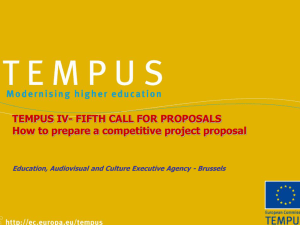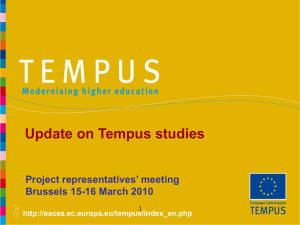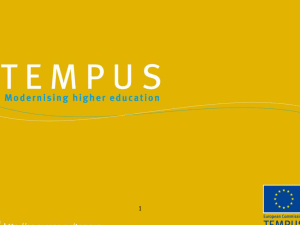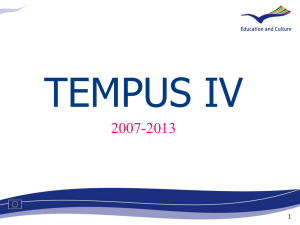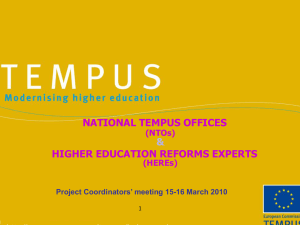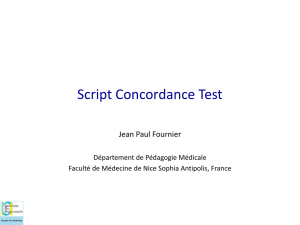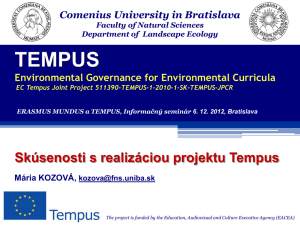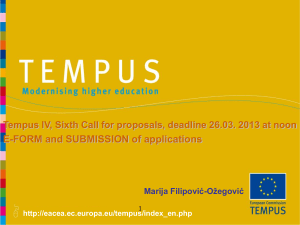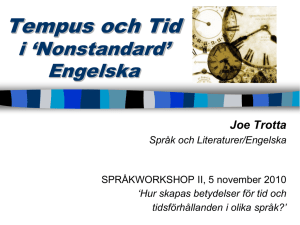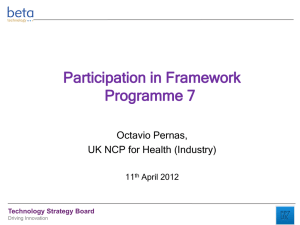6th Call for Proposals
advertisement
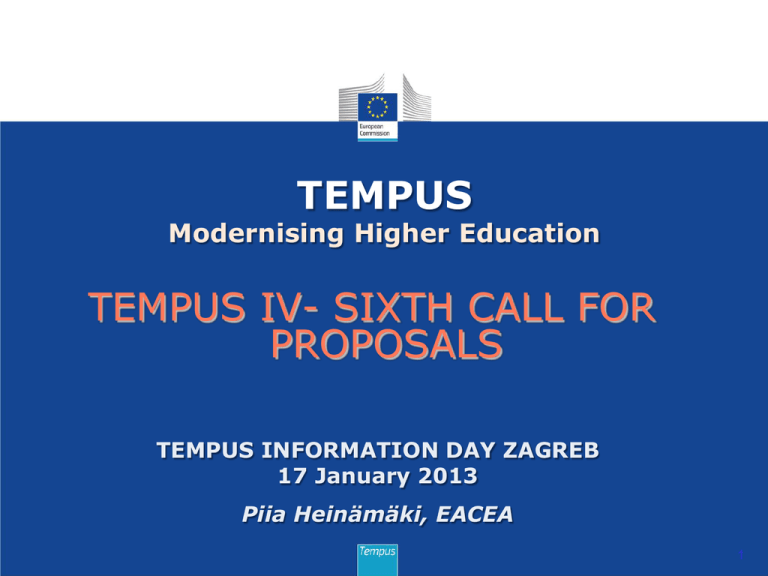
TEMPUS Modernising Higher Education TEMPUS IV- SIXTH CALL FOR PROPOSALS TEMPUS INFORMATION DAY ZAGREB 17 January 2013 Piia Heinämäki, EACEA 1 Outline of the presentation Part I: Novelties under the 6th Call for Proposals Part II: Steps in the selection process Part III: Preparing the application Part IV: Submission procedure Part V: Project assessment by external experts Part VI: Tempus website 2 Part III Novelties of the sixth Call for Proposals 3 TEMPUS IV Indicative budget for projects selected under 6th Call: €129.8 million* REGION/COUNTRIES 2012 2011 2010 € 14.15 million* € 14.5 million € 12.4 million Albania € 1.9; Bosnia and Herzegovina € 2.28; Montenegro €0.76; Serbia: € 6.65; Kosovo: € 2.56 Albania € 1.9; Bosnia and Herzegovina € 2.3; Montenegro € 1.2; Serbia: € 6.6; Kosovo: € 2.5 Albania € 0.9; Bosnia and Herzegovina € 2.2; Montenegro € 1; Serbia: € 6.3; Kosovo: € 2 Southern Mediterranean € 41.7 million € 29 million € 11.4 million Eastern Europe/Caucasus € 42.35 million € 29 million € 11.4 million € 17.1 million € 8.5 million € 4.5 million (for national and multi-country projects involving Russia) (for national and multi-country projects involving Russia) (for national projects) € 9.5 million € 5 million € 9.5 million € 9 million Western Balkans (Russia not included) Bilateral allocation for Russia Central Asia + bilateral allocation to Uzbekistan *An additional budget of € 11,11 million for the Western Balkan countries and € 5 million for Tunisia might become available following the adoption of the relevant Commission's decisions. 4 Novelties under the 6th Call for proposals Updates: Budget : new budget earmarked for Tempus 6th Call and breakdown by regions, as well as bilateral allocation for the Russian Federation and Uzbekistan Dates and deadlines: o Publication of the 6th Call and related documents – early December 2012 o Deadline for submission of applications – 26 March 2013 o Start of project activities: 1 December 2013 National priorities: revision and update by the national authorities in Partner Countries Salary rates: o alignment of the maximum salary rates in EU Member States, in line with other EU programmes for cooperation in HE (LLP); o update of the maximum salary rates in Partner Countries; 5 Novelties under the 6th Call for proposals Eligible Countries Croatia The funding of institutions and organisations based in Croatia (as applicants or partners) under the present call for proposals is subject to the accession of Croatia to the EU expected to take place on 1 July 2013. If by the time of the grant award decision which initiates contracting, Croatia has still not become an EU Member State, participants from this country will not be funded and will not be taken into account with regard to the minimum size of consortia. 6 Novelties under the 6th Call for Proposals Content-related changes Cross-cutting priorities added under Section 2, point 2.5: o subject areas / themes listed as national priorities, which have been insufficiently covered by projects selected under the past Calls for Proposal; o HEIs that have not benefitted / had a limited participation under Tempus IV; will be assessed by external experts within “Relevance” award criterion Award criteria o revised and synthesised o “Relevance” criterion strengthened o assessment grid introduced in the text of the guidelines; 7 Novelties under the 6th Call for proposals Content-related changes Financial conditions few changes occurred following the revision of the Financial Regulations shorter deadlines for payments to projects: 30 days (instead of 45) for the first pre-financing; 60 days (instead of 90 for the second pre-financing and payment of the balance) Audit certificates (=Report of Factual Findings on the Final Financial Report) required for all projects (no longer confined to those above € 750.000) A template will be available together with the documents related to this Call for Proposals on http://eacea.ec.europa.eu/tempus 8 Financial Guarantees The Agency may require any organisation which has been awarded a grant to provide a guarantee in order to limit the financial risks linked to the pre-financing payment(s). Applicants from private higher education institutions should know that, if their project is recommended for funding, a bank guarantee is likely to be required. Private higher education institutions should make sure that they can obtain such a bank guarantee and provide it to the Agency when required. 9 Part II Steps in the selection process 10 Indicative roadmap for selection process – 6th Call for Proposals Steps Date Publication of Sixth Tempus IV Call for Proposals December 2012 Deadline for submission of applications 26 March 2013 Expert assessment April – June 2013 Consultation of Ministries of Education in Partner Countries, EU Delegation and National Tempus offices Mid-July – end August 2013 Award decision End September 2013 Notification of applicants & publication of results October 2013 Preparation and signature of grant agreements October-November 2013 Start of eligibility period 1 December 2013 11 The Call requirements The selection process is based on the assessment of applications against 4 types of criteria: Eligibility Criteria Exclusion Criteria Selection Criteria Award Criteria 12 Eligibility criteria Formal submission requirements Grant size and duration Applicant, Partners and Partnership requirements (number of partners, status of the grant applicant & partners, etc.) National & regional priorities Main reasons for rejection on formal criteria 2012 (1) Out of 676 projects received,100 were rejected for not complying with the eligibility criteria, for the following reasons: Applicant is NOT a higher education institution or association of HEIs non-HEIs: non-profit organisations, foundations established as fund-raiser in universities; international organisations faculties, departments, institutes, research centres or other university components Legal documents NOT signed by the legal representative of the applicant organisation Declaration of Honour Mandates Legal entity form Main reasons for rejection based on formal criteria 2012 (2) Consortium composition: minimum number of higher education institutions NOT respected: Non-profit organisations, faculties, departments, institutes, research centres or other university components cannot count for HEIs Ministry of higher education in Structural Measures projects NOT included Minimum or maximum grant size NOT respected Exclusion and Selection criteria Exclusion criteria: The institution is not in one of the situations described in section 6. Exclusion criteria of the Guidelines (such as bankruptcy, profession misconduct, subject of fraud, corruption, administrative penalty, conflict of interest, etc) Legal person status of the applicant organisation Selection criteria Financial capacity to complete the proposed activities Operational capacity to complete the proposed activities Award criteria Five award criteria defined in the Call and assessed by external experts: Relevance (25%) Good quality partnership (20%) Quality of the project’s content and methodology (25%) Dissemination & Sustainability (15%) Budget and Cost-effectiveness (15%) (1) Relevance The objectives are realistic and relevant for the reform strategies of higher education in the Partner Countries The national/regional priorities are addressed. Key problems and needs of the specific Partner Country/ies and of the potential stakeholders are identified. The real needs & problems of the clearly defined target groups are addressed The project describes how the field of intervention has been explored and how it will contribute to solving the identified problems The project will have an impact on a wide area (including peripheral areas) If based on previous / on-going project, significant added value must be demonstrated It explains how the project proposal was prepared, including partners that had not benefited from Tempus IV before (where applicable) WHERE in the E-form? E.1 The project rationale 18 (2) Quality of the Partnership The partnership includes all the skills, recognised expertise and competences required to carry out the work programme; where applicable, involvement of relevant stakeholders from non-academic sector Balanced distribution of tasks amongst partners, in coherence with the required expertise for each specific activity Applicant and partners have sufficient staff as well as material and financial resources to handle the project Measures to ensure effective communication among the partners are described WHERE in the E-form? B; D.1 Skills and expertise of key staff; E2 Quality of the partnership 19 (3) Quality of Project Content & Methodology The academic / training content and the pedagogical approach; appropriate methodology, the link between wider and specific objectives and between expected outcomes and activities The quality control processes including indicators & benchmarks, risk analysis and the monitoring measures that will be implemented. The management of the project, decision-making process and implementation structure (including measures for conflict resolution). Self-consistency between the project description, LFM, action plan and budget Appropriate level of involvement of HEIs from Partner Countries (i.e., where applicable, the role of Lead partner in work-packages) WHERE in the E-form? E3. The project contents & methodology, F. Workpackages; + Excel tables (Workplan) and LFM 20 (4) Dissemination & Sustainability How information/outcomes of the project will be made available to groups not directly involved How the expected results will be sustainable in the long term (financial, institutional and policy level) The project should consider to: develop a “visual” identity of the project clearly identify target groups plan internal (within HEIs) & external dissemination (in the PC) use a wide range of dissemination tools advertise the first results / products consult and involve the relevant stakeholders (decision makers at national and institutional level, students organisations, professional organisations, private sector) demonstrate arrangements for recognition / accreditation of new courses evaluate and describe what will happen after the end of the project consult Tempus handbook “Sustainability through Dissemination” WHERE in the E-form? E4. Dissemination & Sustainability; F. Workpackages 21 (5) Budget and Cost Effectiveness Implementation of project activities and achievement of expected results and objectives in the most economical way and respecting the Tempus financial rules Respect the salary and mobility rates (according to type of task in the project and not the status of the individual) Plan a reasonable/efficient amount of staff costs for each activity (including reasonable management costs) Use efficiently the mobility periods – making best use of time abroad for maximum benefit Limit the equipment purchase to what is necessary for the implementation of the project Check carefully the eligibility of expenses and account the expenses under the right budget heading Explain the principles for budget allocation amongst partners Eliminate calculation errors and check the consistency of the different parts of the budget Attention! Inflated budgets are marked severely! 22 WHERE in the E-form? E5. Budget & Cost-Effectiveness; Budget Excel Tables Part III Preparing the application 23 When to start? As early as possible Set a realistic time-frame for project preparation (including reception of Mandates from partners) Get information on technical requirements for online submission as early as possible Establish methodology: who will develop what part (narrative, financial, attachments, etc.) Decide on the communication strategy Decide WHO will write the draft; complete the eForm; submit the eForm and attachments 24 How to get started… Read the Call application guidelines carefully (check the changes in the 6th Call vs. 5th Call) First check the changes in the 6th call, in particular national priorities, then decide which of the themes identified in the Call would be best to develop a project Check to what extent your subject/theme is still relevant for the addressed Partner Countries / region Read the Instructions for completing the application form and compulsory attachments* + the eForm User Guide carefully Find interested and relevant partners Consult your NTO / NCP early Be aware of other HE projects in the PC concerned (no double funding) * Declaration of Honour, Workplan and Budget tables, LFM 25 Quality of language & Clarity of Information Choose the language with which all project partners are the most comfortable Explain the concepts and ideas (avoid abbreviations, acronyms) Be precise & specific: provide facts and figures; indicate WHY, by WHOM and HOW something will be done Avoid “patchwork” (copy-paste information) Before submitting, ask somebody who does not know the project to read/proofread the draft proposal. 26 Part IV Submission procedure 27 Submission of the applications: E-form One deadline 26 March 2013 at 12:00 (midday) Brussels time Two steps: 1 - On-line submission of the eForm, including 3 mandatory annexes (Declaration of Honour, Workplan and Budget Excel and Logical Framework Matrix) = unique reference information for the submission deadline. 2 - Administrative and legal documents by post. NO paper copy of the eForm is needed anymore. 28 Submission of the applications: E-form Step 1: On-line submission of the eForm Complete and validate the eForm + correct mistakes Notification of results will be done only by electronic mail. Provide in the eForm, a correct e-mail address, valid during the whole selection process. Check it regularly! Attach the mandatory annexes: Declaration of Honour Workplan and Budget Excel Table Logical Framework Matrix Click on the SUBMIT button of the eForm and an automatic notification is sent with the project Reference number 29 Submission of the applications: E-form Step 2: Administrative and legal documents by post Copy the Project reference number on each of the following documents: Declaration of honour by the legal representative of the applicant organisation Legal entity form Bank identification form Profit and loss accounts/ Balance sheet (if applicable) Mandates Send the complete application package, by the deadline of March 2013 (date tbc), date of postmark, by registered post to the Agency postal address mentioned in the Call for Proposals. Scanned versions are accepted for all supporting documents, even in case the project is selected. HOWEVER originals must be kept by the applicant administration. 30 eForm features An electronic application form that can only be submitted via the internet A form that does not require you to be online when you are filling it in or validating it An interactive PDF form that uses Adobe’s Acrobat Reader (which can be downloaded from Adobe’s website free of charge) An intuitive, easy-to-use application form 31 Practical hints • Read the eForm User Guide before starting to fill the form • Make sure that you have the necessary IT support • Fill in all fields on the front page before starting to fill the other sections • Save the form regularly • Maximum size of attachments 5MB • Do not validate the form until you have finished completing it • The submitted form is locked – cannot be changed 32 Sources of guidance The Instructions (for completing the Application form and the Budget Tables) Rules and guidance on eForm content and the entire application process The eForm User Guide Help with the technical aspects of completing the eForm Still need further assistance...? EACEA-TEMPUS-CALLS@ec.europa.eu 33 Part V Project assessment by external experts 34 Project assessment by external experts Briefing session Two-day briefing on site: general and specific presentations, one-day assessment simulation, based on case study (team work) & handbook, debriefing Assessment Each application assessed by two different experts, by teleworking, supported by the Agency’s on-line assessment tool 1st stage: Each expert carries out an individual assessment 2nd stage: the 2 experts assessing the same proposals consensus discussions consolidated judgements and scores Lead-experts - mediate discussions for consensus, ensure quality assessment outputs; perform 3rd assessment wherever consensus is not reached Debriefing panel with experts Discussion on the quality of the proposals Suggestions for improvement of the evaluation process Selection of external experts Currently > 500 experts names in database covering nationals from EU &Tempus Partner Countries 30% renewal each year, out of which 10% completely new experts An expert can assess Tempus projects for a maximum of three years consecutively Lack of conflict of interest duly checked and must be respected Criteria: Professional experience in thematic areas covered by applications Competences in the Tempus working languages: EN, FR, DE Proved expertise in project cycle management, Tempus Programme and cooperation with the Tempus Partner Countries / Regions Knowledge of the higher education modernisation agenda Part VI Tempus website 37 Information on the Programme How to apply Publications with Programme Guide Calls for Proposals Access to the list of selected projects Selection Results 38 List of selected Tempus IV projects 39 Thank you for your attention! More on: http://eacea.ec.europa.eu/tempus
